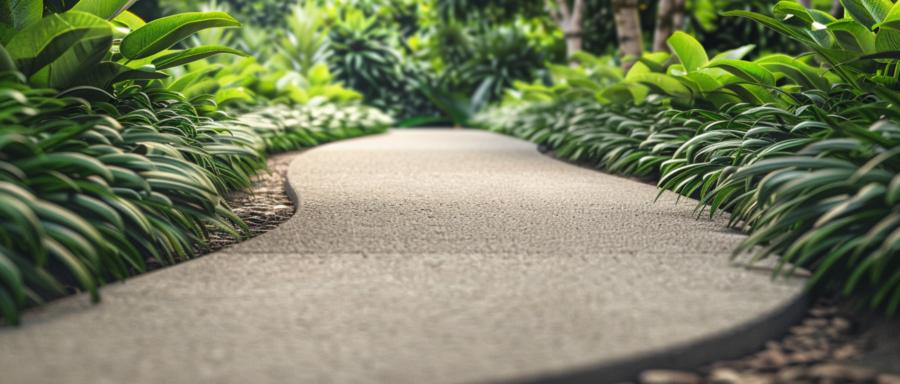The Green Takeover: Algae and Moss Moving In
Algae and moss love nothing more than a shady, damp spot to call home, and concrete surfaces in your garden provide the perfect real estate. Once they get settled, these organisms start spreading faster than gossip at a neighborhood barbecue. Algae, with its slimy green coat, and moss, with its thick, spongy texture, can turn even the most well-kept garden into something that looks like it’s been abandoned to the wilderness.But these green invaders aren’t just ugly. They’re also dangerous. Algae-covered concrete becomes incredibly slippery, turning garden paths into unexpected slip-and-slide zones. And while moss might look soft and harmless, it can actually retain moisture, leading to cracks and damage in the concrete over time. Suddenly, your garden’s peaceful ambiance is overshadowed by the looming threat of a broken ankle.
Garden Wars: The Impact on Nearby Plants
While you might be tempted to let the algae and moss do their thing, thinking they’re just another part of nature, they can actually pose a threat to your garden’s health. Algae can create a layer over the soil and nearby plants, blocking sunlight and hindering photosynthesis. It’s like throwing a wet blanket over your garden’s ability to thrive.Moss, on the other hand, can affect the soil’s acidity. As it decomposes, it releases organic acids that can lower the pH of the soil, making it less hospitable for some plants. If you’ve ever wondered why certain plants just don’t seem to grow well in your garden, moss-covered concrete could be the culprit. It’s the garden equivalent of inviting someone over for tea and then refusing to serve anything but old socks.
Concrete Cleaning: Your Garden’s Best Defense
So, what can you do to prevent algae and moss from turning your garden into their personal playground? The good news is, you don’t need to declare all-out war. Regular cleaning is your best line of defense. Pressure washing is an effective way to remove algae and moss from concrete surfaces, and it’s oddly satisfying too—like watching years of grime melt away in seconds. Just be careful with the pressure settings; you want to clean the concrete, not blast it into oblivion.For a more gentle approach, you can use a mixture of water and vinegar. The acidity of the vinegar helps to kill the algae and moss, while the water dilutes it enough to avoid damaging your plants. Apply the solution, give it some time to work its magic, then scrub away with a stiff brush. It’s a bit of elbow grease, but consider it a free workout with the added benefit of saving your garden from the green invasion.
Prevention: Keeping the Green at Bay
Once you’ve cleaned up your concrete surfaces, the key is to keep algae and moss from coming back. Prevention is always better than cure, especially when the cure involves scrubbing outdoor surfaces in the middle of summer. Start by addressing the root cause: moisture and shade. Trimming back overhanging branches to allow more sunlight to reach your concrete surfaces can make them less appealing to algae and moss.Ensuring proper drainage is also crucial. If water tends to pool on your concrete, algae and moss will take that as an open invitation to move in. Adjust the slope of your concrete surfaces if necessary, or consider installing a French drain to redirect water away from your garden paths and patios. It’s a little investment that could save you hours of cleaning—and potentially a few bruises—from slipping on a slick, algae-coated surface.
Friendly Solutions: Keeping Your Garden Ecosystem Intact
While keeping your concrete clean, it’s important not to harm the rest of your garden in the process. Many commercial cleaners contain harsh chemicals that can be harmful to plants, so opt for eco-friendly options whenever possible. A solution of baking soda and water can be effective against moss, and it won’t damage your garden’s delicate ecosystem. Simply mix, apply, and let it sit before rinsing off. Baking soda may not be as powerful as industrial cleaners, but it gets the job done without turning your garden into a toxic wasteland.For those who prefer a more natural route, there’s always the option of inviting some moss-eating wildlife into your garden. Certain birds and insects enjoy feasting on moss, and while they might not clear your concrete entirely, they can help keep the growth under control. Just be sure to balance this with the needs of your plants—after all, you don’t want your garden to become the local hangout for every critter in the neighborhood.
Bringing It All Home
At the end of the day, keeping your concrete surfaces clean and free of algae and moss isn’t just about aesthetics—it’s about preserving the health of your entire garden. By taking proactive steps to clean and maintain your concrete, you’ll not only prevent these organisms from causing damage, but you’ll also ensure that your plants continue to thrive in a healthy environment. Plus, you’ll avoid the embarrassment of having to explain that the green fuzz growing on your garden path isn’t part of a new eco-friendly trend.So, grab that pressure washer, mix up some vinegar, and give your garden the attention it deserves. After all, a clean garden is a happy garden—and a happy garden is one that won’t send you sliding into your hydrangeas.
Article kindly provided by thejetco.com.au/concrete-cleaning-sydney


